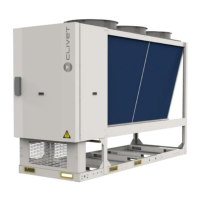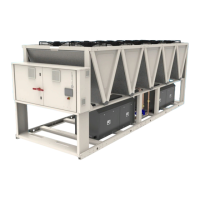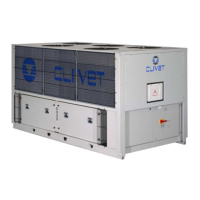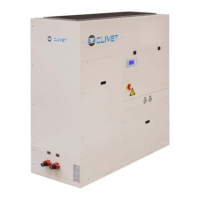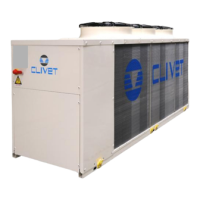Do you have a question about the CLIVET WSAN-YSC4 and is the answer not in the manual?
Covers general safety rules, protection devices, intended use, manual importance, and risk situations.
Guidelines for safe installation, modifications, and breakdown procedures.
Information for users, data updates, and unit identification details.
Procedures for checking delivery and storing the unit correctly.
Safe practices for removing packaging and handling the unit.
Unit placement, functional space requirements, and installation standards.
Methods to limit vibration and protect the unit from external factors.
Avoiding obstructions, managing condensate, and defining safety zones.
Pipe design, water quality requirements, and component limits for corrosion.
Procedures for cleaning and filling new and existing systems.
Protecting against freezing and installing/maintaining water filters.
Water flow-rate, content, and flow switch installation requirements.
Sequence for filling the system and installing non-return valves.
Determining electrical line characteristics and referring to unit electrical data.
Guidelines for laying signal/data lines and managing power input cables.
Usage of remote ON-OFF and precautions for electrical cabinets.
Tables detailing power supply cable sections based on unit size.
Configuring PC connections, remote controls, Modbus, LonWorks, and BACnet.
Ecoshare network control, requirements, and configuration types (A, B, C).
Operations by qualified technicians and a comprehensive checklist before start-up.
Steps after power ON, including circuit checks and parameter adjustments.
Checking compressor resistances, voltage, and configuring parameters.
Managing reduced load operation and checking water flow-rate and start-up reporting.
Understanding the control panel interface elements like LEDs, display variables, and keys.
Changing unit state (ON/OFF/ECO) and operating mode (Cool/Heat).
Modifying setpoints, displaying status, and setting up the scheduler.
Navigating keyboard settings, identifying, and resetting alarms using lists.
Safety warnings and precautions for operations involving R32 refrigerant.
Checks and repairs for electrical components, sealed parts, and intrinsically safe components.
Procedures for refrigerant removal, charging, and unit dismantling.
Safe practices for recovery, transport, marking, storage, and labelling.
General maintenance, intervention frequency, and checks on components like coils, fans, detectors.
Details and specifications for supporting anti-vibration mounts.
Information on anti-seismic mounts and their installation procedures.
Warnings before decommissioning and preventing environmental leaks.
Guidelines for the proper disposal of electrical and electronic equipment (WEEE).
Identifying general, danger zones, and installation-related risks.
Risks associated with electrical parts, moving components, and refrigerant handling.
Technical performance data for Excellence and Premium models in various configurations.
Specifications for compressors, exchangers, fans, and electrical data.
Sound level data for different acoustic configurations (ST, SC, EN).
Cooling/heating operating ranges, correction factors for glycol, and fouling factors.
Dimensional data and support point weights for specific unit sizes.
Dimensional data and support point weights for larger unit sizes.
Covers general safety rules, protection devices, intended use, manual importance, and risk situations.
Guidelines for safe installation, modifications, and breakdown procedures.
Information for users, data updates, and unit identification details.
Procedures for checking delivery and storing the unit correctly.
Safe practices for removing packaging and handling the unit.
Unit placement, functional space requirements, and installation standards.
Methods to limit vibration and protect the unit from external factors.
Avoiding obstructions, managing condensate, and defining safety zones.
Pipe design, water quality requirements, and component limits for corrosion.
Procedures for cleaning and filling new and existing systems.
Protecting against freezing and installing/maintaining water filters.
Water flow-rate, content, and flow switch installation requirements.
Sequence for filling the system and installing non-return valves.
Determining electrical line characteristics and referring to unit electrical data.
Guidelines for laying signal/data lines and managing power input cables.
Usage of remote ON-OFF and precautions for electrical cabinets.
Tables detailing power supply cable sections based on unit size.
Configuring PC connections, remote controls, Modbus, LonWorks, and BACnet.
Ecoshare network control, requirements, and configuration types (A, B, C).
Operations by qualified technicians and a comprehensive checklist before start-up.
Steps after power ON, including circuit checks and parameter adjustments.
Checking compressor resistances, voltage, and configuring parameters.
Managing reduced load operation and checking water flow-rate and start-up reporting.
Understanding the control panel interface elements like LEDs, display variables, and keys.
Changing unit state (ON/OFF/ECO) and operating mode (Cool/Heat).
Modifying setpoints, displaying status, and setting up the scheduler.
Navigating keyboard settings, identifying, and resetting alarms using lists.
Safety warnings and precautions for operations involving R32 refrigerant.
Checks and repairs for electrical components, sealed parts, and intrinsically safe components.
Procedures for refrigerant removal, charging, and unit dismantling.
Safe practices for recovery, transport, marking, storage, and labelling.
General maintenance, intervention frequency, and checks on components like coils, fans, detectors.
Details and specifications for supporting anti-vibration mounts.
Information on anti-seismic mounts and their installation procedures.
Warnings before decommissioning and preventing environmental leaks.
Guidelines for the proper disposal of electrical and electronic equipment (WEEE).
Identifying general, danger zones, and installation-related risks.
Risks associated with electrical parts, moving components, and refrigerant handling.
Technical performance data for Excellence and Premium models in various configurations.
Specifications for compressors, exchangers, fans, and electrical data.
Sound level data for different acoustic configurations (ST, SC, EN).
Cooling/heating operating ranges, correction factors for glycol, and fouling factors.
Dimensional data and support point weights for specific unit sizes.
Dimensional data and support point weights for larger unit sizes.
